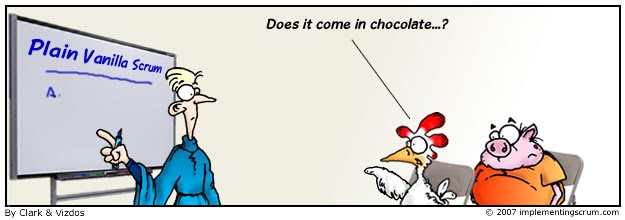Scrum in Plain English?

Written by: S. Pradono Suryodiningrat
We know now that Agile is a philosophy for developing software in a lean and iterative way with plenty of collaboration between the team members, but what are the guidelines for putting it in place?
There are two very popular Agile software development methodologies or structures. One is called Scrum, which you’ve probably heard of before, and the other is called Kanban. You can think of both of these methods as merely guides to developing software in an Agile way. Scrum is probably the most common of the two. Let’s walk through how to implement it or what it looks like in four easy steps. There are a lot of things about Scrum, but these are the four main ones.
Step 1: The Sprint Planning Meeting
You start off with a product backlog which is a big prioritized list of all the things you’ve either decided to work on or may work on. Your team holds a sprint planning meeting which is where you take the most important feature or several from the top of your product backlog and you move it to your sprint backlog. Then you talk about all the work you’re going to need to do in order to implement it. Together, your team writes out what work needs to be done in order to make that feature a reality. You put the work into a project management software, into things called tickets.
Step 2: Start Developing
The core tenant of Scrum is that the work your team does is boxed into a timeframe called a sprint, usually two weeks. Some companies do three-week sprints, and some do four, but two is the most common. Throughout the two weeks, your team works on the things by taking them off the top of the sprint backlog and moving them to in progress and then eventually to done. These are the tickets that they’re moving from column to column.
At the end of the two weeks, you should have completed everything in the sprint backlog. If not, those things go to the next sprint.
Step 3: Standup Meetings
These are very common and very helpful. Standup meetings are these small daily meetings you usually hold in the mornings. Why are they called standup meetings?
The theory here is that if you remain standing as a team and you’re not sitting down, then the meeting will be very brief and just concise in general, and we find that to be pretty true. The goal of the standup meeting is for every team member to talk about what they worked on last, what they’re working on now, and then what they’re going to work on next.
Most importantly, they should bring up any questions or requests for help during the standup meeting, these daily meetings, usually every morning, again, keep everything moving really smoothly.
Step 4: Retrospective Meetings
A retrospective is kind of the opposite of a sprint planning meeting. The retrospective is a meeting you have at the end of each sprint with your team. You get everyone in a room, yourself, the developers, the designers, etc. and you talk about three main things: about the last sprint, what went well, what did not go well, and what questions people have. It’s usually your job as the product manager to lead the team through this. These meetings ensure that everyone that has questions or concerns about the team, or the structure, or your process is getting these things heard, and it keeps everything moving along very smoothly.
All right, so let’s recap on Scrum and the big four major components.
Firstly, is that we have a sprint planning meeting where we take everything from the product backlog, we put it in the sprint backlog.
Secondly, we have the sprint itself, which is a time box period of time like two weeks, three weeks, or four, but the most common is two.
Thirdly, we have the daily standup meetings during the sprint. These are 10- or 15-minute meetings where we keep standing up so that people don’t take too long and we just talk about what you were doing yesterday, what you’re doing today, and what you’re doing tomorrow, and clarify any issues or any collaboration needed.
And finally, we have the retrospective meeting where we talk about what went well during the sprint,
what did not go well, and any outstanding questions that people have.
Alright everyone, hope that helps!


